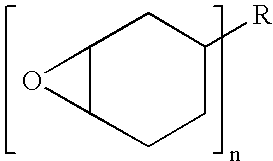Hardener composition for epoxy resins
- Summary
- Abstract
- Description
- Claims
- Application Information
AI Technical Summary
Benefits of technology
Problems solved by technology
Method used
Image
Examples
example 1
[0099] In this example, an anhydride hardener solution of the present invention was prepared in a 5L glass reactor, equipped with a mechanical stirrer, a heating jacket, a N2 inlet and a dropping funnel. 1821.3 g of Dowanol* PMA and 40.3 g of SBM 1A17 were charged in the reactor and heated to 90° C. After the solids were completely dissolved, 1554.8 g of SMA 3000 was added to the solution. After the solids were completely dissolved, 201.3 g of Ricon* 131MA10 was added to the solution. Then the solution turned into a white turbid solution but was homogeneous. After 30 minutes, the solution was allowed to cool down to a temperature of 80° C. and MEK was introduced into the solution at 80° C. After complete cooling of the solution to ambient temperature (−25° C.), the anhydride hardener solution was turbid whitish homogeneous. The hardener solution remained stable during a testing period of 2 months without phase separation nor settling. The theoretical anhydride equivalent weight of t...
example 2
[0101] An anhydride hardener solution was prepared using the same procedure as described in Example 1. The anhydride hardener composition included 1821.3 g of cyclohexanone, 1510.0 g of SMA 3000, 238.7 g of Ricon* 130MA13, 47.7 g of SBM 1A17 and 364.3 g of MEK. The resulting anhydride hardener solution was turbid whitish homogeneous. The hardener solution remained stable during a testing period of 2 months without phase separation nor settling. The theoretical anhydride equivalent weight of the hardener solution was 431 (based on solids).
EXAMLE 3
[0102] An anhydride hardener solution was prepared using the same procedure as described in Example 1. The anhydride hardener composition included 1821.3 g of cyclohexanone, 1490.6 g of SMA 3000, 254.9 g of Ricon* 131MA10, 51.0 g of SBM 1A17 and 364.3 g of MEK. The anhydride hardener solution was turbid whitish homogeneous. The hardener solution remained stable during a testing period of 2 months without phase separation nor settling. The ...
example 4
[0103] An anhydride hardener solution was prepared using the same procedure as described in Example 1. The anhydride hardener composition included 1216.3 g of Dowanol* PMA, 1216.3 g of SMA 3000, 168.7 g of Ricon* 131MA10, 29.2 g of SBM 1A17 and 285.5 g of MEK. The anhydride hardener solution was turbid whitish homogeneous. The hardener solution remained stable during a testing period of 2 months without phase separation nor settling. The theoretical anhydride equivalent weight of the hardener solution was 433 (based on solids).
PUM
| Property | Measurement | Unit |
|---|---|---|
| Temperature | aaaaa | aaaaa |
| Temperature | aaaaa | aaaaa |
| Temperature | aaaaa | aaaaa |
Abstract
Description
Claims
Application Information
 Login to View More
Login to View More - R&D
- Intellectual Property
- Life Sciences
- Materials
- Tech Scout
- Unparalleled Data Quality
- Higher Quality Content
- 60% Fewer Hallucinations
Browse by: Latest US Patents, China's latest patents, Technical Efficacy Thesaurus, Application Domain, Technology Topic, Popular Technical Reports.
© 2025 PatSnap. All rights reserved.Legal|Privacy policy|Modern Slavery Act Transparency Statement|Sitemap|About US| Contact US: help@patsnap.com


